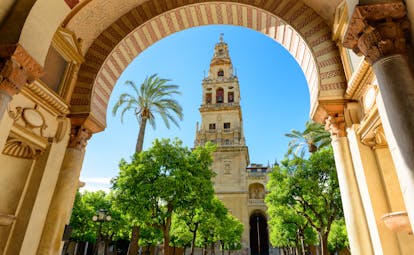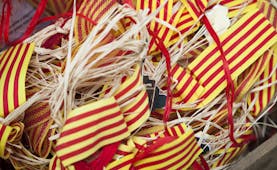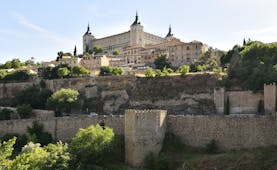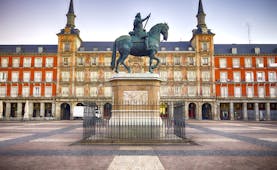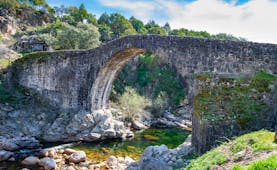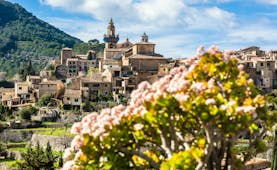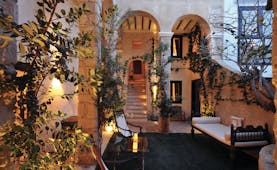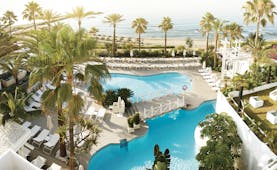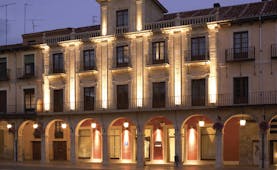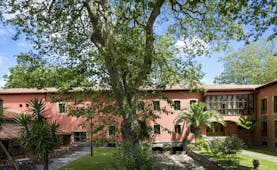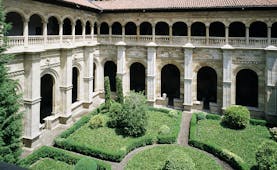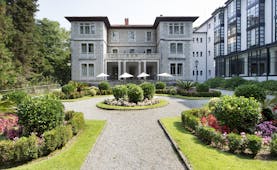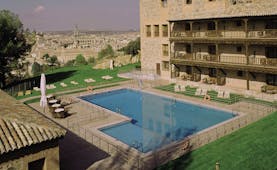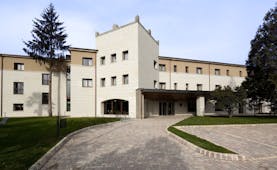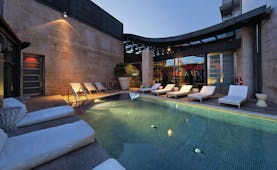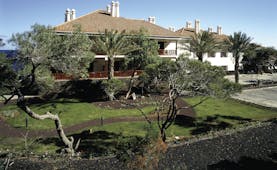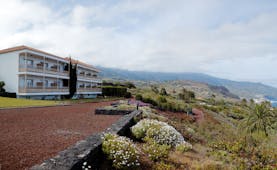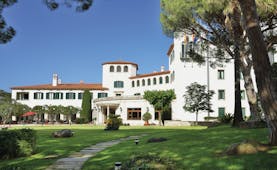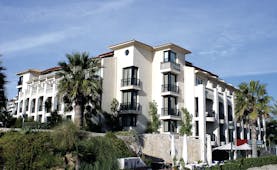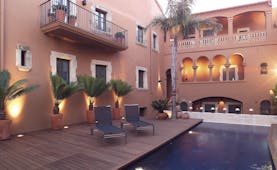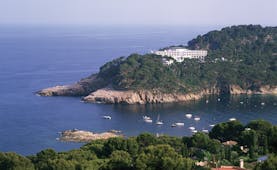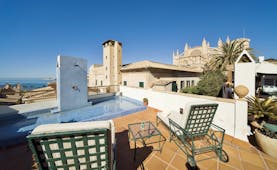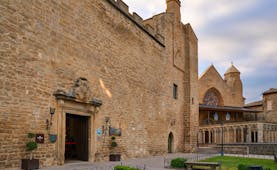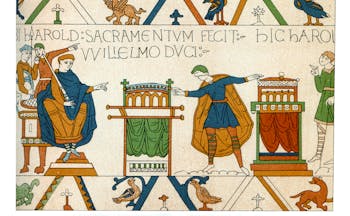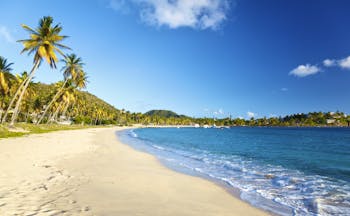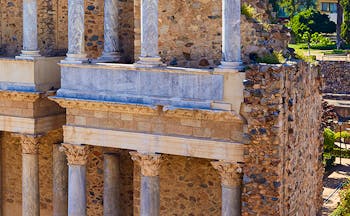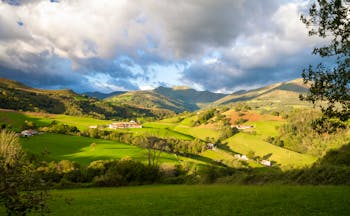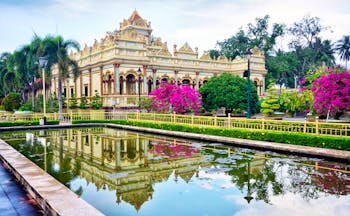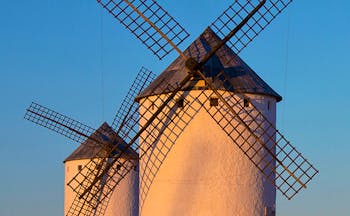Luxury tailormade tour of Spain by air, rail and car from Andalusia to Madrid, Barcelona to San Sebastian
This 14-night touring holiday of Spain travel by air, rail and hire-car, taking advantage of convenient rail connections for some journeys and allowing you to travel at your own pace for others. You fly to Seville and start this grand tour with two nights in Seville in southern Spain, where you soak up the Andalusian culture and visit some well-known tourist attractions, which bear the eccentric mark of traditional Moorish influence. Next, spend one night in Granada, amidst the glory of the Alhambra Palace. The Arabic influence on this region continues in Còrdoba and the Mezquita. From here, travel north to Madrid, and spend two days exploring the extensive artistic heritage of the city before travelling eastwards to Barcelona. Spend a few days in this cosmopolitan seaside city, meandering around its several distinct and vibrant districts, before heading northwest to the Basque Country. Two nights in San Sebastiàn allow you to get a taste for Basque cuisine, as well as sample the delights of the vivid blue ocean. From here, travel westwards through historic cities in northern Spain, stopping off at a 17th century palace in Lerma, in the historic of León, and ending your holiday in Santiago de Compostela in the western region of Galicia.
Highlights
Seville • Visit the Barrio de Santa Cruz in Seville • Real Alcazar in Seville • Alhambra Granada • Granada • Cordoba • Mezquita de Cordoba • Madrid • Prado in Madrid • Barcelona • Visit la Sagrada Familia in Barcelona • Picasso museum in Barcelona • San Sebastian • La Concha beach • Lerma • Follow the route of Saint James • Leon • Santiago de Compostela • Visit the Rias Baixas
Day by day
Begin your touring holiday by flying into Seville, and travelling to the Corral del Rey hotel, where you will spend two nights. This boutique hotel is set in the city’s historic quarter and is therefore the ideal place from which to begin exploration of Seville, the capital of Andalucía and Spain’s fourth largest city.
Art and architecture are of the utmost importance here, and the centre is formed of a maze of narrow lanes and hidden plazas. Be sure to explore the Barrio de Santa Cruz, the most popular neighbourhood in Seville, characterised by pretty lanes lined with trees, shrubs, and the traditional white Spanish houses. This neighbourhood is also home to the Real Alcázar, a royal palace of Moorish, Muslim origins. This building remains one of the most beautiful sights in Seville, with its highly embellished cusped and keyhole arches, its intricate golden ornamentation, and the pools that occupy its inner courtyards. Also surrounded by landscaped gardens, the Real Alcázar is the well-suited for an afternoon’s stroll. The Cathedral and La Giralda bell tower also possess traces of Moorish influence. La Giralda itself resembles the minarets of Marrakech, while the main building is punctuated more obviously by traditional rounded archways and vast stone domes. The eccentricity and variety of architectural styles and features displayed on this cathedral make it an essential landmark to visit as part of this tour. The market stalls around the Plaza del Salvador offer a wide selection of colourful local produce, from the vibrant palate of fruit and vegetables, to the brilliant examples of local art, including the azujelos – locally-made glazed ceramic tiles. Your hotel is an intimate building, whose interior seems to have been inspired by Seville’s entire heritage combined. Winding wooden-floored corridors lead you up to the bedrooms or down into the arched dining rooms, and intricate carvings, paintings, and embroidery, decorate each of the spaces with a uniqueness that feels quintessentially Sevillian.
Collect your hire-car and drive approximately two and a half hours eastwards to Granada, passing through the undulating Andalusian landscape and past miles of olive groves. En-route is the town of Osuna, with its grand church and ornate Palacio del Marques de la Gomera, which may serve as an ideal stop-off point. Further on is the town of Estepa, famous for its biscuits. Spend the rest of the afternoon and evening exploring the Alhambra Palace and gardens. Officially dating back to the 13th and 14th centuries, this collection of buildings, forming almost an entire walled town, was the jewel in the crown of the Emirate of Granada, and now it stands as a testament to the beauty of Arabic art. Its name comes from the red colour of the material that was used to build the original 9th century building that once stood in its place. The vastness of this complex calls for in-depth self-guided exploration, and we would highly recommend spending time in the Palacio de los Leones in Alhambra, and the Palacio de Carlos V. The former is encircled with some 124 thin columns, while the latter is evidence of some later Renaissance development, which breaks the flow of the rest of Alhambra, but nonetheless forms a formidable edifice. Within Granada itself, visit the Generalife, also formerly belonging to the Nasrid Kings, offering them a welcome retreat from the politics of the palace. To complete your experience of Granada, perhaps on the morning of your fourth day, trace the narrow streets of the Albaicin quarter, rich as it is in the shared Spanish-Arabic heritage.
Just two hours’ drive northwest of Granada is the city of Córdoba, a UNESCO World Heritage Site. Drop off your hire car on arrival, and navigate the city by taxi or, to make the most of your time here, on foot. Your hotel for the night is the Hotel Las Casas de la Judería, a charming hotel that occupies a fortress in the city’s Jewish quarter. Traditional Moorish keyhole arches in the lounge, and dark wood beams in the bedrooms, hint at the more exotic roots of the hotel and the city as whole. At the city’s heart is the astounding Mezquita de Córdoba, a mediaeval mosque turned Catholic cathedral, characterised particularly by the rows of red- and white-striped stone pillars that fill its central hall. Its golden altar, though now pertaining to Catholic saints, serves as a beautifully intricate and ornate centre-piece which certainly draws the eye, accompanied by portraits, and the carved crossed-arches that define the ceiling. Other highlights in Córdoba include the fascinating Jewish quarter, laced with uneven stairways that snake their way down narrow streets, and the abundance of Roman ruins.
Catch a late morning train to Madrid, arriving around two hours later. Stay at the five-star Hotel Urban, located within easy reach of the city’s three world-class art galleries and the relaxing Parque del Retiro.
You have the whole day to explore the city, with its many attractive plazas and museums. The Prado Art Gallery might be the first of the three that you visit and houses a vast collection of works from between the 12th and 19th century, including works by Goya, Rubens, and Murillo, all within a magnificent classical building. Next, walk ten minutes to the Reina Sofia gallery, which specialises in modern art, ranging from paintings, including Picasso’s ‘Guernica’, and sculpture, to film, such as a collaborative work of Luis Buñuel and Salvador Dalí. Finally, walk to the Thyseen-Bornemisza, believed to be one of the best private collections of 13th to 20th century art in the world, featuring masterpieces of Goya, Degas, Renoir, and Kandinsky, among others. As this is a private gallery, it is essential to book your tickets in advance, and consider organising a tour to ensure you get the most out of your trip. The hotel itself sits in contrast with the other hotels visited so far on this touring holiday, though its focus is still on indulgence and luxury, it is highly modern in design. Sleek, chic bedrooms are decorated with dark wood floors and beautifully tactile furnishings, as well as having brand new state-of-the-art technology. To put it simply, the rooms are a multisensory delight. The main façade of the hotel, as well as the dining room, are predominantly made of glass, as is the canopy that covers the half-indoor half-outdoor terrace. In Old Madrid, visit the grand arcaded Plaza Mayor at the centre of the city, and the Royal Palace, official residence of the Spanish Royal family, which is often open, at least in part, to the public. Inside, pay particular attention to the use of Spanish marble, the ornate stucco carvings, the frescoes painted by the likes of Giaquinto, Tiepolo, and Bayeu, and perhaps spend time in the Royal Armoury or Royal Pharmacy. Outside, the Plaza Oriente is lined with statues of the Gothic Kings in the central garden, while the Campo del Moro gardens are interspersed by fountains, trees, and statues as well. If time permits on your sixth or seventh day, consider making a quick trip to Toledo, a historic city around 30 minutes away by train which is known as the City of Three Cultures due to the co-existence of Christianity, Islam and Judaism; or, alternatively, travel to the large royal residence and monastery at El Escorial, located about 45 minutes away.
We recommend catching a morning train to Barcelona, arriving around three hours later. Stay at Grand Hotel Central, a luxury five- star hotel in the Gothic district close to the Picasso Museum and historic cathedral.
Spend the day, and the whole of day eight exploring Barcelona, a dynamic and cosmopolitan city which is full of charm and bustle. The capital of Catalonia is famed for its staggering concentration of Gothic architecture such as the cathedral in the heart of the Gothic quarter as well as the Sagrada Familia and other works of Gaudi. Discover the city's unique architecture and rich culture, dine in gourmet restaurants or shop in designer boutiques near Las Ramblas. Divided into a number of different ‘quarter’s, the capital of Catalonia is a city made of many cities. In La Ribera, the former palaces of merchants have become museums, such as the famous Museu Picasso. This quarter is also home to the cavernous Santa Maria del Mar, and the Modernist Palau de la Música Catalana, which is fantastically mesmerising in its interior detail. El Raval was once the most prolific red-light district in the Mediterranean, but its heritage now lies with the Romanesque monastery of Sant Pau, and Gaudi’s Palau Güell. For those who were prompted by their stay in Madrid to look further into Spain’s contemporary art, the glassy, modern Museu d’Art Contemporani, is a fantastic afternoon’s visit. Along the shore, Barcelona boasts of six Blue Flag beaches, and this is also the place to taste some of the best seafood in Barcelona, with the exception, perhaps, of the oysters at La Boqueria market on Las Ramblas. The Eixample is Barcelona’s Modernista centre. For the fullest experience of this quirky and remarkable architectural style, walk along the Passeig de Gràcia, and visit the Manzana de la Discòrdia, Le Pedrera, and of course, Gaudi’s most famous temple, the Sagrada Familia. Its startling interior, modified gothic architecture, and incredible impact on Barcelona’s skyline, make it Barcelona’s most iconic monument, though it stands at a shorter height than Montjuïc Castle, just outside the Montjuïc quarter. Also, in Montjuïc is the recently established Museu Nacional d’Art de Catalunya, beautifully landscaped gardens, and the minamilist, white Fundació Joan Miró, which exhibits the best of its namesake’s work. In the Zona Alta, slighty out of the central city, sit the colourful mosaics of Parc Güell and Horta’s Labyrinth. The density of traditional gothic architecture in the Barri Gòtic also gives Barcelona some of its fame, so we would highly recommend spending some time amidst those winding, maze-like streets. Finish off the day dining back at the hotel, or in one of the gourmet restaurants near Las Ramblas.
In the afternoon, catch a train northwest across the depth of the country passing the undulating lands of the ancient provinces of Aragon and Navarre, crossing the Ebro valley near Zaragoza and then entering the Basque country to reach San Sebastián. The journey time is about 6 hours and you arrive in the early evening. In San Sebastian stay at the beautiful 19th Century Villa Soro, surrounded by pristine gardens and lawns.
San Sebastián is an elegant, cosmopolitan seaside resort set on a beautiful bay only a few miles away from the French border. Of particular interest is the golden town hall, which was formerly the city’s Gran Casino before it closed in 1924, and the spa building, La Perla, built for Queen María Cristina, which is considered to be one of the most beautiful in the world. Many mansions and palaces, such as the Palacio Miramar, summer-house of the royal family in the 19th century, are available for visits, and offer a glimpse into the traditional architecture influenced by the proximity of the French border. Soak up the unique Basque culture, and perhaps dine in one of the many Michelin-starred restaurants which all serve innovative Spanish cuisine. Be sure to visit la Concha beach and the old-town with its lively tapas bars. Off the coast, visit Mount Igeldo for unrivalled views of the sea and the city, accessible via a funicular railway which is the oldest in the Basque Country, running since 1912. Recently named European Capital of Culture 2016, there is much in the way of art and culture to visit, from the striking San Telmo Museum to the small contemporary art galleries hidden away on the streets of Donostia (the old town). During the hot summer months, the town is host to festivals of jazz, theatre, classical music, and film, which only adds to the city’s cultural and artistic feel.
This morning leave San Sebastian after collecting a hire-car for the two hour drive southwest to Lerma, a town just south of the historic city of Burgos. Perhaps stop off en-route to see the cathedral, dedicated to Our Lady of Burgos, dates back to the 12th century and reputedly depicts the entire history of European Gothic art in its architecture, and unique collections.1 kilometre to the west of Burgos will bring you to the Abbey of Santa María la Real de Las Huelgas, which is a former monastery of Cistercian nuns. The complex is comprised of a church, monastery, and the walled premises that offered the nuns protection. Its cloister and inner courtyards provide beautifully serene places to stroll of an afternoon, while its halls and chapels convey something of a more rustic attitude. While the Chapter Room is distinctly austere, the 12th century sacristy door is decorated in a more ornate Arabic design. From here, drive south to your hotel, the Parador Hotel in Lerma, set in the beautiful early 17th century Ducal palace. This places you perfectly to spend a few hours on the vast Ducal square, once fully arcaded, which has the austere collegiate church of San Pedro on one side. From here, navigate your way down to the Arlanza River for a pleasant evening stroll, before retiring to the angular towers of your hotel. Take a relaxed drink in the hotel’s atmospheric, high-ceilinged lounge, that really captures the palatial history of the building.
Continue following the route of Saint James as you drive two hours westwards to the mediaeval walled city of León, whose 13th Century cathedral is renowned for its stunning stained glass. Stay at the NH Collection hotel which has a fantastic location on the city's Plaza Mayor central square. Leon's Cathedral is often referred to as The House of Light due to the magnificence of its stained-glass windows. The panes are numerous and cover a large proportion of the building’s wall space, filtering the light through their radiantly colourful glass, and casting a golden glow on the cavernous interior. To continue part of the discovery of Barcelona, León is home to the Casa de los Botines, designed by Antoni Gaudi. Though this building is somewhat reserved in comparison to his other works, it has a soft, rounded appearance that is typical of his style, and very pleasing to the eye, as well as tall, thin turrets with curved roofs. León is also home to the revolutionary MUSAC. Its unique outlook on contemporary art means that many of its exhibitions are very experimental, which adds intrigue to your visit, as well as making it even more memorable.
Your final city on this grand tour is Santiago de Compostela, the Galician capital and at the end of a drive through stunning green scenery. You spend two nights at the relaxing Hotel Spa A Quinta Da Auga, which is located just outside the city centre.
Santiago de Compostela’s main sight is the majestic cathedral, which is the supposed resting place of Saint James the Apostle, and endpoint of the Saint James Pilgrimage, but there are numerous other historic buildings located throughout the city. The Romanesque cathedral dates back, originally, to the 11th century, though work was not completed until the 13th. The wealth of decorative and iconographic exterior additions was not carved or put in place until the beginning of the 18th century, though this façade is now what the cathedral is known for. The sight of its intricacies, that seem to cover every exposed inch of the stone, is not to be missed. Within, its Plateresque cloister is one of the most important in Spain; rooms such as the library, Chapter Room, and Chapel of Relics annex it, though its beauty is great enough to stand alone. During the summer, the cathedral plays host to several concerts. It is well-worth driving westwards to the Atlantic coast, either in the evening of day fourteen or before departing on your final day, where you can enjoy the phenomenal scenery of the Rias Baixas inlets, for which Galicia is known, and try some of the excellent shell-fish and white wine.
Return your hire-car to the airport and catch your return flight from Santiago de Compostela to London.
It has been a lovely holiday & once again, you did not disappoint. Thank you again for everything. We look forward to contacting you again for our next adventure.Mrs H, July 2025
Holiday price guide Prices from £3,630 per person based on two people sharing a double or twin room.
Holiday Code SNFR01
Call us on 01392 441245
Luxury tailormade tour of Spain by air, rail and car from Andalusia to Madrid, Barcelona to San Sebastian
Begin your touring holiday by flying into Seville, and travelling to the Corral del Rey hotel, where you will spend two nights. This boutique hotel is set in the city’s historic quarter and is therefore the ideal place from which to begin exploration of Seville, the capital of Andalucía and Spain’s fourth largest city.
Art and architecture are of the utmost importance here, and the centre is formed of a maze of narrow lanes and hidden plazas. Be sure to explore the Barrio de Santa Cruz, the most popular neighbourhood in Seville, characterised by pretty lanes lined with trees, shrubs, and the traditional white Spanish houses. This neighbourhood is also home to the Real Alcázar, a royal palace of Moorish, Muslim origins. This building remains one of the most beautiful sights in Seville, with its highly embellished cusped and keyhole arches, its intricate golden ornamentation, and the pools that occupy its inner courtyards. Also surrounded by landscaped gardens, the Real Alcázar is the well-suited for an afternoon’s stroll. The Cathedral and La Giralda bell tower also possess traces of Moorish influence. La Giralda itself resembles the minarets of Marrakech, while the main building is punctuated more obviously by traditional rounded archways and vast stone domes. The eccentricity and variety of architectural styles and features displayed on this cathedral make it an essential landmark to visit as part of this tour. The market stalls around the Plaza del Salvador offer a wide selection of colourful local produce, from the vibrant palate of fruit and vegetables, to the brilliant examples of local art, including the azujelos – locally-made glazed ceramic tiles. Your hotel is an intimate building, whose interior seems to have been inspired by Seville’s entire heritage combined. Winding wooden-floored corridors lead you up to the bedrooms or down into the arched dining rooms, and intricate carvings, paintings, and embroidery, decorate each of the spaces with a uniqueness that feels quintessentially Sevillian.
Collect your hire-car and drive approximately two and a half hours eastwards to Granada, passing through the undulating Andalusian landscape and past miles of olive groves. En-route is the town of Osuna, with its grand church and ornate Palacio del Marques de la Gomera, which may serve as an ideal stop-off point. Further on is the town of Estepa, famous for its biscuits. Spend the rest of the afternoon and evening exploring the Alhambra Palace and gardens. Officially dating back to the 13th and 14th centuries, this collection of buildings, forming almost an entire walled town, was the jewel in the crown of the Emirate of Granada, and now it stands as a testament to the beauty of Arabic art. Its name comes from the red colour of the material that was used to build the original 9th century building that once stood in its place. The vastness of this complex calls for in-depth self-guided exploration, and we would highly recommend spending time in the Palacio de los Leones in Alhambra, and the Palacio de Carlos V. The former is encircled with some 124 thin columns, while the latter is evidence of some later Renaissance development, which breaks the flow of the rest of Alhambra, but nonetheless forms a formidable edifice. Within Granada itself, visit the Generalife, also formerly belonging to the Nasrid Kings, offering them a welcome retreat from the politics of the palace. To complete your experience of Granada, perhaps on the morning of your fourth day, trace the narrow streets of the Albaicin quarter, rich as it is in the shared Spanish-Arabic heritage.
Just two hours’ drive northwest of Granada is the city of Córdoba, a UNESCO World Heritage Site. Drop off your hire car on arrival, and navigate the city by taxi or, to make the most of your time here, on foot. Your hotel for the night is the Hotel Las Casas de la Judería, a charming hotel that occupies a fortress in the city’s Jewish quarter. Traditional Moorish keyhole arches in the lounge, and dark wood beams in the bedrooms, hint at the more exotic roots of the hotel and the city as whole. At the city’s heart is the astounding Mezquita de Córdoba, a mediaeval mosque turned Catholic cathedral, characterised particularly by the rows of red- and white-striped stone pillars that fill its central hall. Its golden altar, though now pertaining to Catholic saints, serves as a beautifully intricate and ornate centre-piece which certainly draws the eye, accompanied by portraits, and the carved crossed-arches that define the ceiling. Other highlights in Córdoba include the fascinating Jewish quarter, laced with uneven stairways that snake their way down narrow streets, and the abundance of Roman ruins.
Catch a late morning train to Madrid, arriving around two hours later. Stay at the five-star Hotel Urban, located within easy reach of the city’s three world-class art galleries and the relaxing Parque del Retiro.
You have the whole day to explore the city, with its many attractive plazas and museums. The Prado Art Gallery might be the first of the three that you visit and houses a vast collection of works from between the 12th and 19th century, including works by Goya, Rubens, and Murillo, all within a magnificent classical building. Next, walk ten minutes to the Reina Sofia gallery, which specialises in modern art, ranging from paintings, including Picasso’s ‘Guernica’, and sculpture, to film, such as a collaborative work of Luis Buñuel and Salvador Dalí. Finally, walk to the Thyseen-Bornemisza, believed to be one of the best private collections of 13th to 20th century art in the world, featuring masterpieces of Goya, Degas, Renoir, and Kandinsky, among others. As this is a private gallery, it is essential to book your tickets in advance, and consider organising a tour to ensure you get the most out of your trip. The hotel itself sits in contrast with the other hotels visited so far on this touring holiday, though its focus is still on indulgence and luxury, it is highly modern in design. Sleek, chic bedrooms are decorated with dark wood floors and beautifully tactile furnishings, as well as having brand new state-of-the-art technology. To put it simply, the rooms are a multisensory delight. The main façade of the hotel, as well as the dining room, are predominantly made of glass, as is the canopy that covers the half-indoor half-outdoor terrace. In Old Madrid, visit the grand arcaded Plaza Mayor at the centre of the city, and the Royal Palace, official residence of the Spanish Royal family, which is often open, at least in part, to the public. Inside, pay particular attention to the use of Spanish marble, the ornate stucco carvings, the frescoes painted by the likes of Giaquinto, Tiepolo, and Bayeu, and perhaps spend time in the Royal Armoury or Royal Pharmacy. Outside, the Plaza Oriente is lined with statues of the Gothic Kings in the central garden, while the Campo del Moro gardens are interspersed by fountains, trees, and statues as well. If time permits on your sixth or seventh day, consider making a quick trip to Toledo, a historic city around 30 minutes away by train which is known as the City of Three Cultures due to the co-existence of Christianity, Islam and Judaism; or, alternatively, travel to the large royal residence and monastery at El Escorial, located about 45 minutes away.
We recommend catching a morning train to Barcelona, arriving around three hours later. Stay at Grand Hotel Central, a luxury five- star hotel in the Gothic district close to the Picasso Museum and historic cathedral.
Spend the day, and the whole of day eight exploring Barcelona, a dynamic and cosmopolitan city which is full of charm and bustle. The capital of Catalonia is famed for its staggering concentration of Gothic architecture such as the cathedral in the heart of the Gothic quarter as well as the Sagrada Familia and other works of Gaudi. Discover the city's unique architecture and rich culture, dine in gourmet restaurants or shop in designer boutiques near Las Ramblas. Divided into a number of different ‘quarter’s, the capital of Catalonia is a city made of many cities. In La Ribera, the former palaces of merchants have become museums, such as the famous Museu Picasso. This quarter is also home to the cavernous Santa Maria del Mar, and the Modernist Palau de la Música Catalana, which is fantastically mesmerising in its interior detail. El Raval was once the most prolific red-light district in the Mediterranean, but its heritage now lies with the Romanesque monastery of Sant Pau, and Gaudi’s Palau Güell. For those who were prompted by their stay in Madrid to look further into Spain’s contemporary art, the glassy, modern Museu d’Art Contemporani, is a fantastic afternoon’s visit. Along the shore, Barcelona boasts of six Blue Flag beaches, and this is also the place to taste some of the best seafood in Barcelona, with the exception, perhaps, of the oysters at La Boqueria market on Las Ramblas. The Eixample is Barcelona’s Modernista centre. For the fullest experience of this quirky and remarkable architectural style, walk along the Passeig de Gràcia, and visit the Manzana de la Discòrdia, Le Pedrera, and of course, Gaudi’s most famous temple, the Sagrada Familia. Its startling interior, modified gothic architecture, and incredible impact on Barcelona’s skyline, make it Barcelona’s most iconic monument, though it stands at a shorter height than Montjuïc Castle, just outside the Montjuïc quarter. Also, in Montjuïc is the recently established Museu Nacional d’Art de Catalunya, beautifully landscaped gardens, and the minamilist, white Fundació Joan Miró, which exhibits the best of its namesake’s work. In the Zona Alta, slighty out of the central city, sit the colourful mosaics of Parc Güell and Horta’s Labyrinth. The density of traditional gothic architecture in the Barri Gòtic also gives Barcelona some of its fame, so we would highly recommend spending some time amidst those winding, maze-like streets. Finish off the day dining back at the hotel, or in one of the gourmet restaurants near Las Ramblas.
In the afternoon, catch a train northwest across the depth of the country passing the undulating lands of the ancient provinces of Aragon and Navarre, crossing the Ebro valley near Zaragoza and then entering the Basque country to reach San Sebastián. The journey time is about 6 hours and you arrive in the early evening. In San Sebastian stay at the beautiful 19th Century Villa Soro, surrounded by pristine gardens and lawns.
San Sebastián is an elegant, cosmopolitan seaside resort set on a beautiful bay only a few miles away from the French border. Of particular interest is the golden town hall, which was formerly the city’s Gran Casino before it closed in 1924, and the spa building, La Perla, built for Queen María Cristina, which is considered to be one of the most beautiful in the world. Many mansions and palaces, such as the Palacio Miramar, summer-house of the royal family in the 19th century, are available for visits, and offer a glimpse into the traditional architecture influenced by the proximity of the French border. Soak up the unique Basque culture, and perhaps dine in one of the many Michelin-starred restaurants which all serve innovative Spanish cuisine. Be sure to visit la Concha beach and the old-town with its lively tapas bars. Off the coast, visit Mount Igeldo for unrivalled views of the sea and the city, accessible via a funicular railway which is the oldest in the Basque Country, running since 1912. Recently named European Capital of Culture 2016, there is much in the way of art and culture to visit, from the striking San Telmo Museum to the small contemporary art galleries hidden away on the streets of Donostia (the old town). During the hot summer months, the town is host to festivals of jazz, theatre, classical music, and film, which only adds to the city’s cultural and artistic feel.
This morning leave San Sebastian after collecting a hire-car for the two hour drive southwest to Lerma, a town just south of the historic city of Burgos. Perhaps stop off en-route to see the cathedral, dedicated to Our Lady of Burgos, dates back to the 12th century and reputedly depicts the entire history of European Gothic art in its architecture, and unique collections.1 kilometre to the west of Burgos will bring you to the Abbey of Santa María la Real de Las Huelgas, which is a former monastery of Cistercian nuns. The complex is comprised of a church, monastery, and the walled premises that offered the nuns protection. Its cloister and inner courtyards provide beautifully serene places to stroll of an afternoon, while its halls and chapels convey something of a more rustic attitude. While the Chapter Room is distinctly austere, the 12th century sacristy door is decorated in a more ornate Arabic design. From here, drive south to your hotel, the Parador Hotel in Lerma, set in the beautiful early 17th century Ducal palace. This places you perfectly to spend a few hours on the vast Ducal square, once fully arcaded, which has the austere collegiate church of San Pedro on one side. From here, navigate your way down to the Arlanza River for a pleasant evening stroll, before retiring to the angular towers of your hotel. Take a relaxed drink in the hotel’s atmospheric, high-ceilinged lounge, that really captures the palatial history of the building.
Continue following the route of Saint James as you drive two hours westwards to the mediaeval walled city of León, whose 13th Century cathedral is renowned for its stunning stained glass. Stay at the NH Collection hotel which has a fantastic location on the city's Plaza Mayor central square. Leon's Cathedral is often referred to as The House of Light due to the magnificence of its stained-glass windows. The panes are numerous and cover a large proportion of the building’s wall space, filtering the light through their radiantly colourful glass, and casting a golden glow on the cavernous interior. To continue part of the discovery of Barcelona, León is home to the Casa de los Botines, designed by Antoni Gaudi. Though this building is somewhat reserved in comparison to his other works, it has a soft, rounded appearance that is typical of his style, and very pleasing to the eye, as well as tall, thin turrets with curved roofs. León is also home to the revolutionary MUSAC. Its unique outlook on contemporary art means that many of its exhibitions are very experimental, which adds intrigue to your visit, as well as making it even more memorable.
Your final city on this grand tour is Santiago de Compostela, the Galician capital and at the end of a drive through stunning green scenery. You spend two nights at the relaxing Hotel Spa A Quinta Da Auga, which is located just outside the city centre.
Santiago de Compostela’s main sight is the majestic cathedral, which is the supposed resting place of Saint James the Apostle, and endpoint of the Saint James Pilgrimage, but there are numerous other historic buildings located throughout the city. The Romanesque cathedral dates back, originally, to the 11th century, though work was not completed until the 13th. The wealth of decorative and iconographic exterior additions was not carved or put in place until the beginning of the 18th century, though this façade is now what the cathedral is known for. The sight of its intricacies, that seem to cover every exposed inch of the stone, is not to be missed. Within, its Plateresque cloister is one of the most important in Spain; rooms such as the library, Chapter Room, and Chapel of Relics annex it, though its beauty is great enough to stand alone. During the summer, the cathedral plays host to several concerts. It is well-worth driving westwards to the Atlantic coast, either in the evening of day fourteen or before departing on your final day, where you can enjoy the phenomenal scenery of the Rias Baixas inlets, for which Galicia is known, and try some of the excellent shell-fish and white wine.
Return your hire-car to the airport and catch your return flight from Santiago de Compostela to London.
It has been a lovely holiday & once again, you did not disappoint. Thank you again for everything. We look forward to contacting you again for our next adventure.Mrs H, July 2025
Holiday price guide Prices from £3,630 per person based on two people sharing a double or twin room.
Holiday Code SNFR01
Our prices include
● Flights with Easy Jet from Gatwick to Seville and Santiago de Compostela to Gatwick
● Standard class rail from Cordoba to Madrid, Madrid to Barcelona and Barcelona to San Sebastian
● Hire of a Group B car for eight days (three in Andalucia and give in northern Spain)
● 2 nights’ bed and breakfast in a Dreamer double room at the Hospes in Seville
● 1 night’s bed and breakfast in a Dreamer double room at the Hospes in Granada
● 1 night’s bed and breakfast in a Dreamer double room at the Hospes in Cordoba
● 2 nights’ bed and breakfast in a Dreamer double room at the Hospes in Madrid
● 2 nights’ bed and breakfast in a Standard double room at the Grand Hotel Central in Barcelona
● 2 nights’ bed and breakfast in a Standard double room at the Villa Soro in San Sebastian
● 1 night’s bed and breakfast in a Standard double room at the Parador de Lerma
● 1 night’s bed and breakfast in a Standard double room at the NH Collection Plaza Mayor in Leon
● 2 nights’ bed and breakfast in a Standard double room at the Hotel Spa A Quinta da Auga in Santiago de Compostela
● Concierge service and Expressions Holidays regional helpful hints
Our prices do not include
● Early check-in or late check-out at any hotels (although we can arrange this on request at additional cost)
● Any other services not mentioned above, such as transfers and meals except breakfast at hotels
● Personal holiday insurance. This is essential and cover should be in place from when you book the holiday.
● Local tourist tax, usually between Euros 1 and 3 per person per night, and payable locally to the hotel
Additional information
Travel times for this touring holiday
Seville to Granada by car 2 hours 30 minutes
Granada to Córdoba by car 2 hours 15 minutes
Córdoba to Madrid by rail 1 hour 40 minutes
Madrid to Barcelona by rail 2 hours 45 minutes
Barcelona to San Sebastián by rail 5 hours 40 minutes
San Sebastián to Lerma by car 2 hours 35 minutes
Lerma to León by car 2 hours
León to Santiago de Compostela by car 3 hours 30 minutes
Call us on 01392 441245
Luxury tailormade tour of Spain by air, rail and car from Andalusia to Madrid, Barcelona to San Sebastian

Hospes Las Casa del Rey de Baeza is a charming, 4-star boutique hotel in the heart of Seville's Old Town. Delicious, modern Anadalusian cuisine and refreshing rooftop cocktails make it a restorative haven from the bustle of the city.
Dreamer double room

Hospes Palacio de los Patos is a luxury 5-star boutique hotel in an excellent central location. The serene spa, delicious cuisine and rooftop bar make it an excellent spot to recuperate after a day enjoying the sights of Granada.
Dreamer double room

Hospes Palacio del Bailío is a luxury 5-star boutique hotel in a central location. Gourmet cuisine, excellent spa facilities - featuring original Roman baths - and serene grounds offer guests a calming oasis in the city.
Dreamer double room

Hospes Puerta de Alcalá is a luxury 5-star boutique hotel in an excellent central location. Gastronomic delights and excellent spa facilities make this an ideal spot to recuperate after enjoying the cultural and historical sites of Madrid.
Dreamer double room

Hotel Urban is a 5-star boutique art hotel in an excellent central location. A Michelin-starred restaurant and wonderful rooftop terrace with swimming pool provides the perfect space to relax after a day spent exploring Madrid.
Standard double room
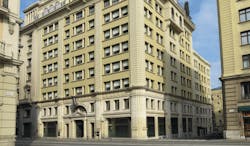
Grand Hotel Central Barcelona is a luxury 5-star hotel in an excellent city centre location. Excellent spa facilities, delicious cuisine and stunning rooftop pool make it an ideal spot to recuperate after a day enjoying the city's sights.
Standard double room

Villa Soro in San Sebastián is an exclusive 4-star boutique hotel in a fantastic location near the old town and the beach. Beautiful gardens and luxurious accommodation make this a truly relaxing and restorative retreat.
Standard double room

NH Collection León Plaza Mayor is a 4-star boutique hotel in an excellent central location. Juxtaposing historic architectural features with modern facilities, it is a comfortable, elegant spot to recuperate after enjoying the sights of León.
Standard double room

A Quinta da Auga Hotel Spa is a rural hotel surrounded by immaculate gardens. On the bank of the River Sar, this hotel provides a tranquil and indulgent retreat in comfortable and luxurious surroundings.
Standard double room
It has been a lovely holiday & once again, you did not disappoint. Thank you again for everything. We look forward to contacting you again for our next adventure.Mrs H, July 2025
Holiday price guide Prices from £3,630 per person based on two people sharing a double or twin room.
Holiday Code SNFR01
Call us on 01392 441245
Luxury tailormade tour of Spain by air, rail and car from Andalusia to Madrid, Barcelona to San Sebastian
About Andalusia
An Expressions tailor-made holiday to Andalusia offers the chance to explore a holiday destination famed for its indulgent climate and coastal appeal. The region cannot deny its fair share of sun, sea and sand, but what is often neglected to mention is the region's immense variety. Comprising of eight unique provinces, Andalusia spans west to east from the wetlands and the Atlantic Ocean to the deserts and the popular Costa del Sol on the Mediterranean Sea. Poised at the southern-most tip of the Iberian Peninsula, Andalusia acts as a gateway between the European and African continents, harbouring a myriad of influences that speak of the layers of civilisation that have roamed and inhabited the land. From the vibrant cities to the tiny white-washed villages, from vast sierras to the extensive coastline, Andalusia is a region of contrasts which promises an authentic luxury holiday.
Highlights of Andalusia
With 800km of coastline, there are plenty of beaches to choose from - facing the Atlantic are the long, sandy beaches of the Costa de la Luz, extending south from the Portuguese border to Tarifa; covering the area between Malaga and Gibraltar is the famous Costa del Sol, known for its numerous beach resorts which range from the cheap and cheerful to exclusive luxury; to the south of Granada is the Costa Tropical, a stretch of coast with sandy coves and a pleasant microclimate; and to the east is the more rugged Costa de Almeria. A number of luxury resorts and hotels are located along each of these coastlines. Surrounding Granada is the Sierra Nevada, a mountain range where the Spanish mainland's highest peak can be found and home to white-washed mountain villages. In the far east of Andalusia is the Sierras de Cazorla, Segura y Las Villas Natural Park, the largest protected area in Spain where you can find hiking trails, mountain villages and many wild animals. Further south is The Cabo de Gata Natural Park, a land and sea reserve near Almeria which is home to unspoilt scenery and an abundance of wildlife. In the west of the region is the Doñana National Park, an extensive area in the delta of the Guadalquivir River which includes marshland and sand dunes and is a breeding ground of the endangered Iberian Lynx. Thanks to the region's great variety in landscapes, culture and cuisine, a luxury holiday to Andalusia is sure to be a delightful experience.
Cultural highlights of Andalusia
Many of the Andalusia's cultural highlights can be found in the three Moorish cities of Cordoba, Granada and Seville, all of which are home to a number of excellent luxury hotels. Cordoba, a UNESCO World Heritage Site and former centre of Muslim control during Andalusia's colonisation by the Islamic Empire. At the city's heart is the astounding Mezquita de Cordoba, a mediaeval mosque turned Catholic cathedral with endless Moorish arches, columns and glinting tiles of vibrant hues. Other highlights include the fascinating Jewish quarter and Roman ruins galore. Nearer the coast is Granada, where Islamic rule endured the longest and the magical Alhambra remains as a monument to this legacy. A 9th century palace fortress, it guards over the city from an elevated crag amongst vast, aromatic gardens. To the west, on the peaceful plains of River Guadalquivir, Seville quietly awaits discovery along with its three World Heritage Sites: the Alcazar palace, the gothic Cathedral and the General Archive of the Indies. Other towns and cities of interest in Andalusia include Jerez de la Frontera, where you can visit the sherry bodegas which make the city famous and watch the dressage displays which are held at The Royal Andalusian School of Equestrian Art; Cadiz, the oldest city in Europe which is surrounded almost entirely by water; Ronda, a spectacular city which is split in half by a narrow gorge; Malaga, birthplace of Picasso and home to a Museum which displays a collection of his work; the small town of Baeza, where you can find stunning examples of Renaissance architecture; and Almeria, a coastal city which is dominated by the Alcazaba, the largest Moorish fortress in Spain. During your stay in Andalusia make sure to witness the seductive art of flamenco. Alluring, passionate and cathartic, it's easy to understand how this gypsy tradition has become one of the most familiar emblems of Spanish culture.
Festivals in Andalusia
There are a huge number of local festivals held in villages, towns and cities throughout Andalusia, many of which have a religious significance. 5 January: Three Kings parades, February: Shrove Tuesday Carnivals, February: Seville Tapas Fair, February to March: Jerez Flamenco Festival, March/April: Holy week celebrations, April to October: Seville Bullfighting season, April/May: Seville Spring Fair, April/May: Úbeda Classical Music Festival, Mid May: Jerez Horse Fair, June to July: Granada Music & Dance Festival, June - July: Cordoba Guitar Festival, August: Malaga Summer Fair, September: Ronda bullfighting festival, November: Granada Jazz Festival.
Gastronomy in Andalusia
Cuisine in Andalusia is diverse, varying throughout the region and combining Arabic flavours with more common Mediterranean ingredients such as seafood, olive oil and an abundance of fresh fruit and vegetables. As the birthplace of tapas, Andalusia is an excellent place to try the snacks which are often served free with drinks in Granada. Other Andalusian specialities include Serrano ham from the Sierra Nevada and sherry from Jerez de la Frontera, as well as dishes such as ‘Ajo blanco’ (a white gazpacho), ‘Espetos de sardina’ (roasted sardines), ‘Huevos a la flamenca’ (baked eggs with vegetables) and ‘Fritura de pescado’ (mixed fried fish).
Call us on 01392 441245
Luxury tailormade tour of Spain by air, rail and car from Andalusia to Madrid, Barcelona to San Sebastian
About Barcelona
An Expressions tailor-made holiday to Barcelona include the very best four and five star hotels in the city, all of which provide a superb base for a short city break or as the starting point for your holiday to Catalonia. First founded by the Romans, Barcelona is now a dynamic and cosmopolitan city on the Mediterranean coast which is charming and exciting all at once. The capital of Catalonia is famed for its staggering concentration of Gothic architecture as well as surreal wonders such as the Sagrada Familia, making it one of the most visited cities in Europe. Previously a relatively overlooked industrial city, Spain’s second city played host to the Olympic Games in 1992, prompting a period of extensive regeneration and leading to its reinvention as a lively holiday destination. Unique architecture, a rich culture with art galleries and museums abound, gourmet restaurants, lively bars, designer boutiques, golden beaches, parks and gardens – Barcelona has it all. An exhilarating destination for a city break, with much more to discover...
Highlights of Barcelona
There are a huge number of day trips and excursions which those on holiday in Barcelona can enjoy. These include: The Monastery of Montserrat, a religious complex in a spectacular setting atop craggy mountains with chapels, hermits’ caves and numerous nature trails, reached by a one hour train journey followed by an exhilarating cable-car ride; Wineries in towns such as Sant Sadurní d’Anoia and Vilafranca del Penedès, both around one hour away by train; Catalan towns and cities including Tarragona (a port city with fascinating Roman remains), Girona (an ancient walled city with a fascinating history), Vic (a quintessentially Catalan town with an outstanding market) and Figueres (home to the renowned Dalí Theatre-Museum), all of which can be easily reached by train or bus.
Cultural highlights of Barcelona
There are numerous places of interest that visitors should see during their luxury holiday in Barcelona: La Rambla, Spain’s most famous street which is busy at almost any time of the day or night with flower stalls, tarot readers, musicians and mime artists lining the wide walkway which is shaded by trees. The Gothic quarter, a maze of narrow streets and plazas in the old town with architecture dating back to the 14th and 15th centuries. This historic area is home to Catalonia’s government building, the town hall, a former royal palace and the imposing and intricately-decorated La Seu Cathedral, which includes a beautiful cloister. Montjuic, a fortress-topped hill in the south of the city with museums, art galleries and restaurants dotted throughout the spacious gardens. This is also the setting of the 1992 Olympic stadium, the large open space enjoys panoramic views of the city and sea, and is accessible by cable car from the port, by funicular from the base of the hill, by bus or on foot. The harbour area, where almost 3 miles of sandy beaches meet the Olympic port and the older area of Barceloneta, known for its numerous fish restaurants. Parc de la Ciutatella, a popular park with gardens, a boating lake, a zoo, several museums and the striking Catalan Parliament building. Eixample District, a vast area towards the north of the city which was built according to a grid system and is full of unique buildings which were designed in a ‘Modernista’ (Catalan Art Nouveau) style by the famous Antoni Gaudí and his contemporaries. The most famous building which was designed by Gaudí is the Sagrada Familia, an unconventional church building which is filled with symbolism but is still unfinished. Other famous works of art which feature Gaudí’s trademark curved lines, decorated chimneys, elaborate wrought iron and mosaic decorations include Parc Guell, a colourful park which is a UNESCO World Heritage Site; Casa Batlió, a house with a fascinating interior and exterior and La Pedrera, a curved apartment building.
Gastronomy in Barcelona
Cuisine in Barcelona is similar to the rest of Catalonia, taking inspiration from both nearby France and from central Spain whilst making use of local ingredients available including seafood, fresh vegetables, meat and game. Typical dishes include ‘Crema Catalana’ (a Catalan version of a Crème Brûlée), ‘Pa amb tomàquet’ (bread smeared with tomato, oil and garlic), ‘Fideuá’ (a variant of Paella which uses pasta in place of rice), ‘Zarzuela’ (a seafood stew which is made with fish, prawns, squid and mussels), ‘Escudella’ (a stew containing vegetables, meat, rice and pasta) and unusual ‘sea and mountain’ combinations which use both meat and seafood. Barcelona is home to some of Spain’s best restaurants, with gastronomic chefs creating innovative cuisine and over 20 boasting at least one Michelin star. The best fish and seafood can be found in restaurants in the Barceloneta district, or if you want to buy some local produce yourself then head to the busy La Boqueria market on La Rambla.
Climate in Barcelona
Late spring and early autumn are the best times to go on holiday to Barcelona, as the weather is warm with temperatures of around 20 degrees centigrade. Summer is often unbearably hot with some shops and restaurants closing in August as locals leave the city to get away from the heat. Winter is mild with occasional rain and average temperatures of 10 degrees but is an enjoyable time to visit as Christmas markets are held and many celebrations take place.
Call us on 01392 441245
Luxury tailormade tour of Spain by air, rail and car from Andalusia to Madrid, Barcelona to San Sebastian
About Spanish Basque country
An Expressions tailor-made holiday to the Basque Country in northern Spain include the very best four and five star hotels across the region, including seaside retreats, city properties and vineyard hotels in La Rioja. Lying at the point between the Pyrenees and the Bay of Biscay is the Basque Country, a name which refers both to an autonomous community within Spain and to a larger cultural area which comprises parts of Spain and France. Known in Spanish as the Pais Vasco, you will find a unique culture here with fascinating traditions and a regional language which is widely spoken throughout. The region's key attraction is the closeness of both sea and country - the spectacular coastline boasts sweeping sandy beaches and rugged cliffs, stunning sunsets over the ocean and surf breaking on rocks; but only a short drive inland are rolling green hills and flower filled fields. Lying around 10 miles away from the north coast is the vibrant and energetic riverside city of Bilbao, whilst further east is San Sebastian, an elegant seaside resort set on a beautiful bay only a few miles away from the French border. Stretching away from the Basque coast and forming the border with France are the Pyrenees, where rocky mountains with waterfalls and lakes stretch into Navarre, a region which is dotted with unspoiled villages and mediaeval towns which line the pilgrimage route to Santiago de Compostela. Further west are the undulating hills of La Rioja, a region whose name is synonymous with the fine wines that it produces. Although parts of the region are heavily industrialised, there are many areas of unspoiled countryside as well as over 150 miles of coastline, making it a superb destination for a luxury holiday. The natural environment has long played a huge role in the lives of the region's inhabitants, with charming fishing villages along the coast which celebrate marine festivals as well as mountain farmers inland whose traditions remain unchanged. Throughout the region, visitors are sure to experience the unique culture of the Basque country through its language, cuisine and traditions.
Cultural highlights of Spanish Basque country
Bilbao's Guggenheim Museum, a Frank Gehry-designed landmark which transformed the city. The charming old town of San Sebastian, located between the beach and the river. Vitoria-Gasteiz, the capital of the Basque Country which is home to a mediaeval old town and two cathedrals. Guernica, a small town which was bombed during WWII and inspired a famous painting by Picasso. Fishing villages between Bilbao and San Sebastian including Bakio, Bermeo, Zumaia and Lekeitio, some of which are home to wonderful beaches and are also popular surf spots. Hondarribia, a historic town situated on the border with France. Pelota, a traditional ball game which is played throughout the region on a two-walled court. Numerous bars across the region which serve ‘pinchos’ (a Basque version of tapas), including those in Logroño. Wine-producing towns across La Rioja where visitors can enjoy cellar tours and wine tastings, which can also be enjoyed at the luxury vineyard hotels which we feature. Yuso and Suso Monasteries, a UNESCO World Heritage Site in La Rioja. The fortress city of Pamplona, renowned for the annual bull running festival.
Gastronomy of Spanish Basque country
The Basque Country is renowned for its varied and innovative cuisine, with numerous Michelin-starred restaurants found across the region. San Sebastian alone is home to eight Michelin-starred restaurants, two of which have been included within the top ten of Restaurant magazine's list of the world's 50 best restaurants. Wine is of course an incredibly important product, primarily in La Rioja which is known for its high-quality reds as well as a number of good white and rosé wines. A regional variation of tapas called ‘pinchos' can be found throughout the Basque Country and Navarre, frequently eaten as a snack in bars. Regional cooking varies according to location, with plenty of fresh fish and shellfish to be found along the coastline and a greater use of meat and game further inland. Local dishes include ‘Bacalao' (salt cod), ‘Marmitako' (fresh tuna stew), ‘Cordero al Chilindron' (spicy lamb stew) and ‘Txangurro relleno' (stuffed spider crabs).
Festivals in Spanish Basque country
19 to 20 January: San Sebastian Drum Festival, 29 June: Haro Wine Festival, 6 to 14 July: Los Sanfermines Bull Running Festival (Pamplona), July: San Sebastian Jazz Festival, 4 to 9 August: Festival of the Virgin Mary (Vitoria-Gasteiz), August: Bilbao's Big Week, September: San Sebastian International Film Festival, September: San Mateo Wine Festival (Logroño).
Climate in Spanish Basque country
The Basque Country's climate is generally quite mild and wet, although there is some variation between coastal and inland areas. The Basque coast experiences relatively high levels of rainfall, cold winters and warm summers where temperatures regularly reach 25 degrees, whilst some areas further south enjoy a Mediterranean climate, with hot summers and little rain.
Call us on 01392 441245
Luxury tailormade tour of Spain by air, rail and car from Andalusia to Madrid, Barcelona to San Sebastian
About Green Spain
Green Spain features some of the best four and five star hotels in the regions of Galicia, Asturias and Cantabria in northern Spain, including coastal properties, city hotels and rural retreats. From the pretty rivers on the west coast of Galicia to the spectacular mountains of Asturias and the prehistoric caves of Cantabria, Green Spain is a picturesque area in the north of Spain. With quiet sandy beaches, green landscapes, charming villages and Romanesque architecture lining the famed pilgrimage route which leads to Santiago de Compostela, there is plenty to discover. Although many of those who go on holiday to northern Spain simply pass through en route to Santiago de Compostela, the entire region has much to offer. Stunning beaches are almost untouched, whilst the mild climate has produced rich vegetation which covers unspoilt countryside. Both along the coast and further inland there are attractive cities, towns and villages with a wealth of historical, architectural and cultural sights to discover. Galicia and Asturias have strong cultural identities, both fiercely defending their Celtic traditions which include playing bagpipes, and even speaking their own languages. In the far west is the remote region of Galicia, known as ‘The land of a thousand rivers’ thanks to the numerous wide inlets that run into the sea. The Atlantic coastline is rugged, with rocky headlands, idyllic beaches and isolated fishing villages, whilst the interior is hilly and overwhelmingly green. To the east is the Principality of Asturias, an enchanting region of contrasts with secluded beaches as well as peaceful countryside. Forming a natural barrier in the south are the towering Picos de Europa mountains, a spectacular area with small mountain villages, lush pastures, emerald forests, sheer gorges and glittering lakes. Next is the small, mountainous region of Cantabria, where white sand beaches line the coastline facing the Bay of Biscay, separated by rugged headlands.
Highlights of Green Spain
Santiago de Compostela cathedral, the supposed resting place of St James the Apostle, from whose rooftop you can enjoy unforgettable views over the old town. The attractive Galician cities of Ourense, Pontevedra and Lugo, all with historical sites including Roman architecture. Maritime cities along the Atlantic coastline including A Coruna, Ferrol, Vigo, and Baiona. The Tower of Hercules, an ancient Roman lighthouse near A Coruna. Galicia's fjord-like inlets known as the Rías Altas (along the north-west coast) and the Rías Baixas (along the southwestern coast). The dramatic Cape Finisterre, so called because it was thought to be the westernmost point in Europe. The stunning Picos de Europa mountains, home to a diverse range of walking trails and the atmospheric Covadonga Sanctuary. Oviedo, the attractive capital of Asturias which is home to some remarkable pre-Romanesque churches. Altamira Caves, a UNESCO World Heritage Site with ancient rock paintings which are up to 20000 years old. Comillas, a beachside town with impressive architecture including a building designed by Antonio Gaudí. Pleasant towns along the shores of the Cantabrian Sea including Gijón and Llanes. Santillana del Mar, a picturesque village inland with a number of well-preserved mediaeval buildings. Santander, a lively port city with a historic quarter, a modern centre and the famous El Sardinero beach.
Festivals in Green Spain
February/March: Carnivals celebrating Lent, March: Vigo Reconquest Festival; March/April: Holy week celebrations, July: ‘A Rapa das Bestas’ horse festival held in Galician villages, July: Saint James the Apostle festival in Santiago de Compostela, July: Nava Cider Festival (near Oviedo), August: Festival of San Roque in Betanzos (near A Coruna), August: Santander International Festival.
Gastronomy in Green Spain
Cuisine in the north of Spain tends to be simple and hearty, making good use of the excellent local produce including abundant fish and seafood, plentiful meat and game and a great variety of vegetables. The regions produce a range of dairy products, from the mild soft cheeses of Galicia to the smoked cheese of Cantabria and the blue cheeses of Asturias. Asturias is known for its dry cider, whilst Galicia produces high quality wines, both crisp whites and fruity reds, as well as a strong liqueur, ‘Orujo.’ Local dishes include ‘Vieras de Santiago’ (Scallops, the symbol of St James, which are baked in their shells), ‘Empanada gallega’ (a Galician meat pasty), ‘Lacón con grelos’ (pork shoulder with chorizo, turnips and potatoes), ‘Caldo gallego’ (thick soup with meat, potatoes and beans), ‘Fabada’ (an Asturian stew with pork and beans), ‘Tarta de Santiago’ (an almond cake), ‘La quesada’ (a Cantabrian cheesecake) and ‘Sobaos Pasiegos’ (Cantabrian sponge cakes).
Climate in Green Spain
Green Spain has a wet and mild climate with warm summers and cool winters. Summer is a popular time to visit northern Spain as the weather is sunny yet comfortable, but you can expect good weather in Spring and Autumn as well. Rain falls throughout the year although there is little during the summer months. Temperatures are rarely extreme, although mountainous areas can be very cold in winter with snow falling.
Call us on 01392 441245
Luxury tailormade tour of Spain by air, rail and car from Andalusia to Madrid, Barcelona to San Sebastian
About Heart of Spain
An Expressions tailor-made holiday to the Heart of Spain feature some of the best four and five star hotels in central Spain, featuring vineyard hotels, rural estates and city properties. Located at the geographical heart of Spain is its vibrant capital, Madrid, where days can be filled with art galleries and atmospheric outdoor cafes, and evenings promise an energetic nightlife. Surrounding the city are the dry plains of the country's central plateau which are divided by spectacular mountain ranges and dotted with numerous castles, magnificent cathedrals and ancient Roman ruins. The regions which make up Spain's central plateau have all played a hugely important role in the history of modern Spain, which is evident in the numerous castles which were built to protect towns and villages as the Moors fought the Christians in the 10th and 11th centuries. These are some of the least visited parts of Spain where few tourists venture outside of the main cities, ensuring that visitors will leave feeling like they have discovered something new. At the centre of Spain is Madrid, where atmospheric cobbled streets link bustling squares which are filled with pavement cafes and flea markets, whilst tree-line boulevards are overlooked by neo-classical buildings. Surrounding the city are the dry plains of the country's central plateau which are divided by spectacular mountain ranges and dotted with numerous castles, magnificent cathedrals and ancient Roman ruins. To the north of Madrid is Castilla y León, an elevated region which has played a hugely important role in the history of modern Spain. Rolling countryside is littered with historic cities, isolated villages and mediaeval castles, built by the Christians to defend against the Moorish invaders. Salamanca, Avila, Segovia, León, Valladolid and Burgos are all home to a wealth of art and stunning architecture, including Gothic cathedrals and Roman structures. Away from the cities are natural attractions including mountain ranges and nature reserves, with wheat fields and vineyards covering the high plateaus. To the south and east of Madrid is Castilla-La Mancha, an expansive region with dry plains stretching towards mountains in the distance. The predominantly flat scenery is made up of olive groves, wheat fields, extensive vineyards, hilltop castles and the iconic windmills described by Cervantes. Head to the historic city of Toledo, where Christian, Jewish and Arab cultures blend to create a popular tourist destination, or to Cuenca, a dramatic town where houses seemingly dangle over a plunging gorge. Further west towards the border with Portugal is Extremadura, a region with green pastures and rolling hills, forests and fertile river valleys, as well as charming towns boasting stunning examples of Roman architecture. Elaborate palaces and manor houses are found in clusters throughout the region, built by conquistadors with gold from the New World.
Highlights of the Heart of Spain
The three world-class art galleries which make up Madrid's Golden Triangle of Art, home to works by Pablo Picasso, Salvador Dalí and Francisco de Goya. The historical sights of Old Madrid, including the lavish Royal Palace, the grand Plaza Mayor and the city's spiritual centre, Puerta del Sol. Parque del Retiro, a popular spot for relaxation in the centre of Madrid with a boating lake. El Escorial, a large royal residence just outside Madrid which also functions as a monastery and is where many Spanish monarchs are buried. The Gothic cathedrals of León, Burgos and Toledo which feature stunning stained glass, mediaeval art and elaborate sculptures. The numerous castles which are scattered across the region including the Gothic-style Belmonte Castle, the Mudejár Coca Castle and the Moorish Alcazaba of Badajoz. The university city of Alcalá de Henares, birthplace of Cervantes, the 16th century author who wrote about the adventures of Don Quixote. The walled city of Ávila. The university city of Salamanca. Segovia, with its Roman Aqueduct and distinctive castle. Cuenca, a picturesque old town with houses which appear to hang over a gorge. The iconic windmills which sit on the plains near Consuegra. Roman ruins in Mérida. Elaborate palaces and manor houses in Trujillo and Cáceres. The wine-producing regions throughout central Spain including Ribera del Duero, La Mancha and Valdepeñas where visitors can visit vineyards and enjoy wine tastings. Mountain ranges which divide the central plateau, with many opportunities for walking and rock climbing.
Festivals in the Heart of Spain
February: Caja Madrid Flamenco Festival, February to March: Madrid Carnival, February to March: Madrid Contemporary Art Fair, March/April: Holy week celebrations, May: San Isidro bullfighting festival (Madrid), May/June: Toledo Corpus Christi processions (Toledo), July to August: Madrid summer arts festival, October: Saffron Rose Festival (Consuegra), October: Cervantes Week (Alcala de Henares), October to November: Madrid Autumn Festival
Gastronomy in the Heart of Spain
As expected, Madrid is home to some excellent restaurants serving a great range of cuisine from throughout Spain and around the world. Roasted meat and game as well as a variety of broths and stews are common features on menus throughout central Spain, where traditional cooking is simple and hearty. Cuisine varies slightly between the regions, with more paprika and saffron being used in the south. Various pulses are grown on the plains of Castilla y León, whilst Manchego cheese produced in La Mancha and high quality Ibérico ham is produced in Extremadura. There are a number of wine regions which produce high-quality red and white wines. Local dishes include ‘Pollo a lo Padre Pero’ (chicken with a spicy sauce), ‘El frite’ (fried lamb), ‘Sopa de ajo’ (garlic soup), ‘Pisto manchego’ (similar to ratatouille), ‘Yemas’ (a rich dessert made with egg yolks).
Climate in the Heart of Spain
The climate of central Spain is generally quite extreme, with extremely hot summers and bitterly cold yet dry winters. Rainfall is generally quite low thanks to the mountains which surround the region. Madrid can be almost unbearable in the summer months as temperatures reach 40 degrees, whilst during the temperatures regularly drop below freezing. Spring and autumn are the best times to visit as temperatures are warm and pleasant, although there is increased rainfall.
Call us on 01392 441245
Luxury tailormade tour of Spain by air, rail and car from Andalusia to Madrid, Barcelona to San Sebastian
About Madrid
An Expressions tailor-made holiday to Madrid is a chance to explore this lively and passionate capital city with a laid-back lifestyle. Atmospheric cobbled streets link bustling squares which are filled with pavement cafes, whilst tree-lined boulevards are overlooked by neo-classical buildings. Our luxury holidays to Madrid feature some of the best four- and five-star hotels in the city, including elegant hotels and more boutique properties. Visitors to Madrid will find plenty to fill their days. Art and culture play an important role, primarily thanks to the three world-class art museums which make up Madrid’s Golden Triangle of Art, home to works by Pablo Picasso, Salvador Dalí and Francisco de Goya. Illustrating the city’s rich history are the sights of Old Madrid, including the lavish Royal Palace, the grand Plaza Mayor, and the city’s spiritual centre – Puerta del Sol. There are plenty of designer shops to browse throughout the city, as well as small boutiques and flea markets which visitors might stumble across. It is after dark that Madrid really comes alive as the streets, parks and open-air cafes fill with people of all ages and the bars and clubs remain open until dawn. What better way to recover from a late night than to while away a morning in the Parque del Retiro, strolling through the beautiful gardens and perhaps hiring a rowing boat on the park’s tranquil lake. For those who wish to escape the energetic city, a number of towns are located nearby which make for an interesting day trip.
Highlights of Madrid
Numerous squares including the historic Plaza Mayor, the setting of bullfights and executions during the Spanish Inquisition. The Royal Palace, a lavish building which was constructed in the 1700s and is still used today for state occasions. The Prado Museum, one of the largest art galleries in the world which contains an impressive selection of Spanish paintings including works by Goya and El Greco. Reina Sofia Museum, displaying modern works including Picasso’s ‘Guernica’. Thyssen-Bornemisza Museum, based on a private art collection which illustrates the history of western art and includes pieces by Goya, Degas and Renoir. Retiro Park formerly used by the royal family and now a popular spot for relaxation. The Teatro Real, an important opera house with performances of opera and dance. Almudena Cathedral. Gran Vía, a famous street which is lined by theatres and shops. Debod Temple, an ancient Egyptian temple which was rebuilt in Madrid in the 1960s. The Santiago Bernabéu Football stadium, home to Real Madrid. El Rastro Market, an open-air flea market which is held on Sundays. Ventas Bullring where bullfights take place every week during the bullfighting season.












